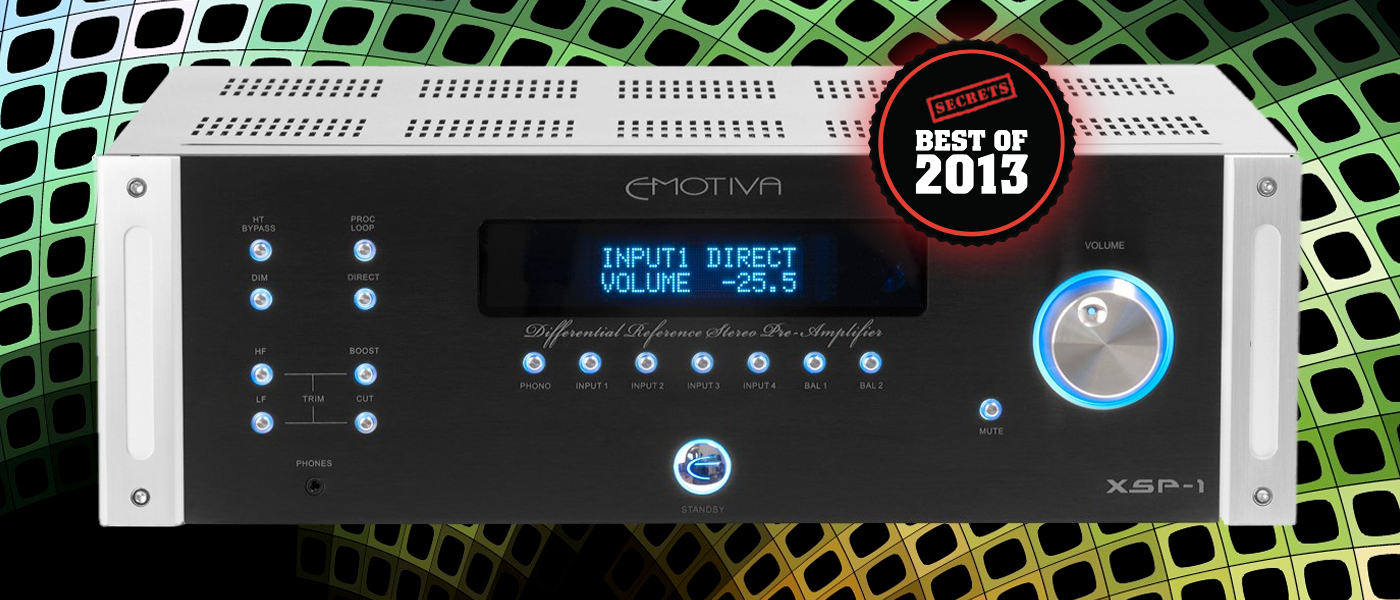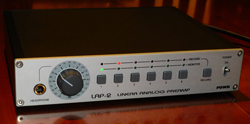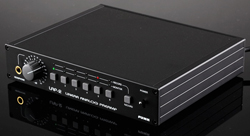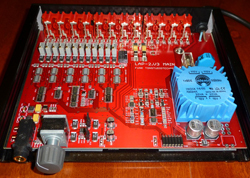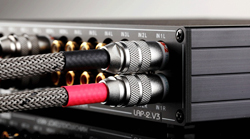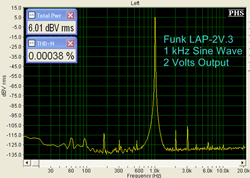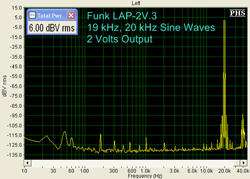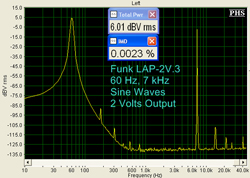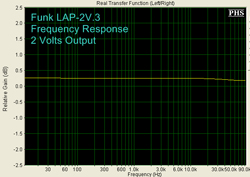Introduction to the Funk LAP-2.V3 Preamplifier
It is becoming increasingly popular for high end audio buffs to use pro studio gear in their home systems. This preamp from a German manufacturer that makes pro gear is in keeping with this trend. As a matter of fact, the literal English translation of their name is “Funk Recording Studio Technology”. Will the amazing specs of the Funk Tonstudiotechnik LAP-2.V3 translate into amazing sound?
The Funk Tonstudiotechnik LAP-2.V3 is an unbalanced active preamplifier that provides switching and gain for up to six stereo inputs. The architecture of this unit is based on a buffered matrix switch that operates without mechanical contacts. The manufacturer’s stated design goal was to achieve high reliability, long service life and consistent audible performance. This preamplifier was developed from Funk’s professional reference monitor systems that are being used in a number of mastering studios.
The manufacturer makes performance claims that put the little LAP-2.V3 in the company of greats. This would be a S/N Ratio of 137.5 dB, THD of 0.0001%, Input Impedance of 2 Mega Ohm and a flat frequency response from 0.5 Hz to 200 kHz. These are specifications at the limits of laboratory grade test gear and are near the theoretical limit of what is possible to achieve regardless of price.
FUNK LAP-2.V3 PREAMPLIFIER SPECIFICATIONS
- Design: Solid State Stereo Preamplifier
- Maximum Voltage Output: 13.8 Volts RMS
- MFR: 1 Hz – 200 kHz ± 0.2 dB
- Inputs: 6 Unbalanced RCA
- Outputs: 2 Pair Unbalanced RCA, 4 Pair Record Out RCA and ¼” Headphone
- Input Impedance: 2 M?
- Output Impedance: 62 ?
- Dimensions: 1.6″ H x 8.25″ W x 6.7″ D
- Weight: 3.3 Pounds
- MSRP: $1,100 USD
- Funk
- SECRETS Tags: Funk, Tonstudiotechnik, Preamplifiers, Amplifiers, Audio
Design of the the Funk LAP-2.V3 Preamplifier
The Funk LAP-2.V3’s circuit design is based on a sophisticated active matrix switch. The primary advantages of this topology are that you have no mechanical contacts in the signal path, and there are no signal losses, even with numerous outputs. Important secondary benefits include low crosstalk and immunity to phase shifts. The matrix switch is buffered with a set of high quality op amps which leads to the super high input impedance.
This preamp features six selectable line level inputs, two preamp outs, four record outs and a front panel headphone jack (1/4″). All jacks are high quality with gold-plated contacts.
The power supply is a super quiet choke-regulated design with filter caps and low power draw – only 4.7 watts under normal operating conditions. It provides exemplary isolation from power line irregularities.
Funk selected an ALPS analog volume potentiometer in designing the LAP-2.V3. Funk’s promotional materials indicate that digitally controlled volume controls compress dynamics and introduce distortion at low gain levels. They are willing to allow small traces of interchannel crosstalk and tracking nonlinearities to get the lower distortion results. Funk says they hand select the stereo pots and align the resistor network around each pot to obtain less than 0.5 dB of channel imbalance. This should be inaudible in any conceivable real world environment. Bear in mind that these numbers are measured on a new unit, and the imbalance would be expected to increase as the unit ages.
The Funk’s headphone amp was a conundrum to me. Most high end headphone amplifier output stages are designed using discrete circuits or a mix of discrete and integrated circuits. Not here. Instead, Funk uses a low distortion op amp that is rated for higher impedance headphones (300 – 600 ohm). Funk includes a current limiter circuit to prevent overload so the unit will work with low impedance phones and earbuds. Funk says that my review unit is from an early production run. The new units have more current output, but Funk acknowledged that the headphone driver’s current capability is ultimately limited by the unit’s small power supply and the thermal limit imposed by the box’s size. Be that as it may, Funk recommends headphones in the 200 – 600 ohm range for best results.
Normal operation of the Funk LAP-2.V3 is solid and confidence-inspiring. The user depresses the input button to select the input for playback and the matrix engages with a satisfying mechanical click. Holding the button mutes the line outputs but retains headphone out and the green light for that input dims. To select a source for recording, the user holds the “Record” button and then depresses the desired input and the red light for that input illuminates. The detented volume control has a precise and competent action.
The LAP-2.V3 has a great deal of underlying flexibility including features such as jumpers to covert the line outs to a fixed level, provisions for a processor loop by way of additional jumpers, and the option to trim gain levels for each input to accommodate the varying levels of your different source devices.
The Funk has many RCA jacks on the back panel. These jacks are grouped in rows and columns but they are really differentiated in large part by their labels. So the end user is cautioned to be careful when connecting components to this preamp. There are cases where the user may introduce a feedback loop and this could cause problems like spoiling a recording or damaged equipment. We are working on a separate technical article that will cover this topic.
Funk designed this unit to have a line output of 25 dBu, which is 13.8 volts RMS. In order to achieve this high an output voltage, Funk had to run the chips at their Absolute Maximum Rating. This design choice is perplexing to me because the target output voltage is far higher than what is required for consumer equipment and running a chip at its Absolute Maximum Rating is not good practice. This could lead to future reliability problems.
The Funk LAP-2.V3 is available in a number of finishes – white paint or anodized in black, blue, dark red, silver, or gold. My review unit was configured for use in North America (110 V, 60 Hz) but the power cord still had a German plug, so I had to dig out my Euro-style adapters for the review.
The Funk LAP-2.V3 Preamplifier In Use
The review unit was sent to me from another reviewer, and so it didn’t need to be broken in before the evaluation period. I still put it through normal daily use for two weeks before I started my critical listening.
My subjective evaluation of this preamp was largely based on listening to digital media over my Oppo BDP-83SE. This was the best source I had on hand at the time and offers the highest probability to pinpoint the sonic character of the Funk Tonstudiotechnik LAP-2.V3. Plus, the Oppo has a variable analog out, so I was able to compare the sound of the Funk versus a direct feed from the Oppo to my power amp.
I listened to numerous CD’s and SACD’s during the review period. I also watched several Blu-ray movies, listening to the high resolution PCM 2.0 track when available or downmixed to 2 channels from the lossless surround sound track on discs that do not have a 2-channel track. My setup included an SVS SB 13 Ultra subwoofer that I have in for review. This sealed sub has a 13.5″ driver, a 1,000 watt RMS amp and a dual band parametric EQ. I dialed in the EQ and wound up with very flat response from the main listening seat (± 3 dB, 20 Hz – 80 Hz). So the system was set up and primed for optimal performance throughout the audible spectrum.

I wanted to mention the subwoofer here because the Funk’s bass response on jazz, rock, and pop had a full, round and addictive quality. There was no trace of compression or smoothing of the bass, and the notes were rendered with natural harmonics. The synergy between the SVS sub and the Funk preamp was plainly heard. It was most apparent on discs with lively bass lines such as the Steely Dan “Gaucho” SACD.
It wasn’t just the bass that impressed me but also the mid and upper ranges. This disc came through with no perceptible grain – the Funk preamp passed the extremely smooth output of the Oppo. The channel separation was also excellent, with pinpoint placement of musicians. But, when pushed too hard, the backup singers tended to smear into a single mass. Be that as it may, the most endearing quality of the LAP-2.V3 was its surprising rhythmic qualities. Take “My Rival” and its syncopated beat for example. Through the Funk, all the sound was in perfect synchrony. This little preamp’s phase integrity offered pacing beyond reproach.

I don’t want this to sound overly cliché, but the Funk proved to be so transparent, that I was having a hard time describing any sort of a sonic signature. The 2012 Blu-ray of The Lorax is a case in point. I watched this whole movie, planning to use it as the basis to describe the sound of the Funk. Later, when I was going through my listening notes, this is what I found, “Clean, dynamic, extended, timbrally accurate, channel separation, transient speed, Foley effects, bass response, harmonies, musical score.” It was nothing more than a complete list of everything that sounded right over the Funk LAP-2.V3, and which I look for in various audio products that I review!

So, I had to get back to some pure music listening if I were going to characterize this little component. That’s when I fired up my Neil Diamond Hot August Night/NYC. This Blu-ray was filmed live at Madison Square Garden in 2008. It is a very satisfying production that features an artist who sings with so much joy and love in everything he performs. The adoring audience is so enamored with the performance, that every last individual in the massive crowd winds up on their feet by the midpoint of the closing medley of his classic hits.
The very familiar and distinctive quality of Diamond’s voice was unfettered during “Love on the Rocks”. There was a pleasing frequency balance from the low bass all the way up through the highest octaves on “Pretty Amazing Grace”. Then the horns on “Solitary Man” were right in front of me with excellent presence and spacing.
The Funk LAP-2.V3 never introduced any trace of an unpleasant sound. There was simply no harshness of any kind. I pulled the LAP-2.V3 out of the system and fed the amps directly off the Oppo BDP-83SE pre-outs for a few songs on Hot August Night to make a direct comparison. This experiment confirmed that there was no audible insertion loss with the Funk LAP-2.V3 in the system – nearly pure transparency was achieved.
After such a stirring performance from the Funk LAP-2.V3 as a linestage, I was very excited to give its headphone output a run for the money. But I was sadly disappointed in the performance I heard. Matching headphones with an amplifier can be akin to mating low efficiency speakers with low output triode amps – the proof is in the pudding. You can’t always go off the specifications. The true test of a good match comes in the listening.

I started my evaluation of the Funk’s headphone stage by listening to a pair of Audeo PFE 232. These dual armature earbuds are rated at 47 ohm nominal. Auditioning the Redbook CD of Amy Winehouse – Lioness, Hidden Treasures, I honestly thought there was something wrong with the earbuds or the CD at first. It was overly bright and clinical sounding, particularly over these low impedance buds.
So then I tried the Funk with a pair of 300 ohm Sennheiser HD 800’s. These are very revealing headphones. Even into these higher impedance phones, the signal overloaded on crescendos. The bass was lean and detached, leaving a grainy and bright presentation overall. So, it was as if the headphone stage is there to help with record monitoring, but passes along very little information as to the quality of the recording. Bear in mind that the newer production models are claimed to output twice the current of my review unit.
The Funk LAP-2.V3 Preamplifier On the Bench
At 1 kHz and 2 volts RMS output the THD+N I measured was a very respectable 0.00038%. Funk measures lower distortion using an Audio Precision at the factory. My test set up is very capable. It has a native distortion floor of about 0.0003%, so the distortion I measured of the LAP-2.V3 was at or near the limits of detection for my test setup.
In this test, the input signals are simultaneous 19 kHz and 20 kHz sine waves at 1:1. The B-A peak at 1 kHz is 123 dB below the test signal. This is a superlative test result.
The LAP-2.V3’s Intermodulation Distortion was only 0.0023 %.
The measured frequency response of the Funk LAP-2.V3 is essentially flat between 10 Hz – 96 kHz (the limits of my test gear). Notice that the major divisions of the vertical axis are only 0.5 dB.
Conclusions about the Funk LAP-2.V3 Preamplifier
The Funk LAP-2.V3 is an interesting product. From a subjective listening standpoint, it is very good as an active preamp albeit one that overloaded when driven hard. When driven within its limits, the sound I obtained was fantastic, with nothing added and nothing taken away.
This really struck me one evening as I was reviewing the Blu-ray of Pitch Perfect. This movie is about the collegiate acapella singing scene. The little Funk preamp was so clean and extended, with such excellent phase linearity, that I just couldn’t believe I was listening to a recording. It really did open the window and let me feel that the singers were right there in the room with me. In all honesty, it was a breathtaking experience. This preamp’s excellent performance is reflected in its bench test measurements. These show distortion and roll off characteristics that are several orders of magnitude below the threshold of human hearing.
Funk put their resources into the buffering amp and the matrix switch. This is the meat and potatoes for a product like this, and so I can’t argue with that aspect of the design. I personally wished they had a better headphone amp. I would also like to see a remote control for home users. The unit has four tape loops. I wish they would cut that down to one or two. They could use the cost savings to improve the power supply and headphone driver while including additional CMOS switching to mute the active recorder and avoid one potential avenue for feedback.
My final thought is that this product is a decent linestage with some good design decisions in many areas but driving the IC’s at their maximum voltage might cause reliability problems. Funk is on the right track with this design, but a few design and implementation tweaks are necessary in order for this unit to garner a blanket recommendation.


